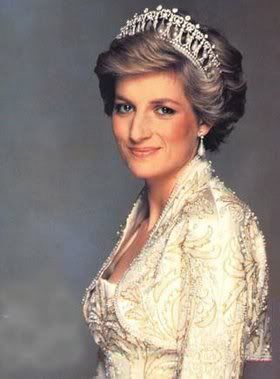I'll admit that I fully participated in the mass hysteria following the news of
Princess Diana's death. Apart from nearly overdosing on Xanax - not an easy task, I might add, although they were the last ones I ever took - I wept bitterly and shook my fist at all those I felt were responsible, from the paparazzi scum who treated her like prey to supercilious bureaucrats in Buckingham Palace who considered her an inconvenience they couldn't control to narrow-minded unfeeling people everywhere who lacked the compassion to fully comprehend that it was specifically her darker side that made her brightness all the more radiant.

My friends and family (and especially my cold fish of a boyfriend) could barely understand the dimensions of my grief; in fact, I could barely understand it myself. But if ever there was a better demonstration of the power of Princess Diana that was it. People who'd never met her felt like they lost their best friend, and for those of us who snivelled through that awful week, who got up at 3 AM to watch her funeral on TV seven terrible days later, it wasn't some remote public figure or garden-variety celebrity who had died alongside
Dodi Fayed in the
Pont d'Alma tunnel that balmy evening in Paris: she was our friend.
That day, August 31st, 1997, was the worst day of my life to that point; though its tragedy has since been replaced by other, more personal ones, the day I lost my Princess is still in the Top Five. And I'm still shaking my fist at those I feel were responsible, though by now that list has dwindled to just one: Diana herself.
After all the flowers and tears and column inches*, after all the enquiries and autopsies and folderol, it turns out she wasn't wearing a seatbelt. No forensic evidence has ever emerged that her seatbelt had been tampered with, because she's clearly shown on film not putting one on when getting into the
Mercedes-Benz S280 W140 (driven by
Henri Paul, who also died) that would be her undoing. The only one who survived that crash, her bodyguard
Trevor Rees-Jones, was thought to be wearing a seatbelt, until a 2006 inquest called
Operation Paget proved that he wasn't.
If I've learned one thing from Diana's death, it's
always wear a seatbelt.
*Which were so many, they were better measured in column miles.
*
every morning that awful week i woke up thinking "no, it wasnt a bad dream" - i went to the candlelight vigil in San Francisco and cried so much that week. We lost a bright light that week. We needed her. I miss her still.
ReplyDeleteMy name is Robert Kegan and i would like to show you my personal experience with Xanax.
ReplyDeleteI am 19 years old. Have been on Xanax for 60 days now. I have periodic panic attacks, particularly at social gatherings, riding in cars, and walking into rooms full of people (i.e. late to class). I felt that the medicine worked, but I felt that it created urges to take more than directed when the rebound anxiety hit, so I switched from alprazolam to clonazepam (Klonopin). I think xanax is great for airplanes and adjunctive treatment with ssri's, but by itself I don't think xanax has much too offer except as a short term treatment for panic attacks, klonopin is less sedating and seems to prevent future anxious episodes without causing cravings, and tolerance seems to build up much slower than xanax does.
I have experienced some of these side effects -
I sometimes felt invisible, like nobody could notice anything I was doing. Occasionally it would make me fall asleep if I had to stay in one spot for too long. After a fairly short period of time I would feel moderate rebound anxiety.
I hope this information will be useful to others,
Robert Kegan